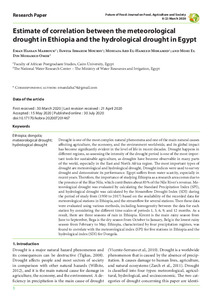Datum
2020-07-30Autor
Mabrouk, Eman HassanMoursy, Fawzia IbrahimMohamed, Mostafa Abd El-HameedOmer, Mohi El Din MohamedMetadata
Zur Langanzeige
Aufsatz

Estimate of correlation between the meteorological drought in Ethiopia and the hydrological drought in Egypt
Zusammenfassung
Drought is one of the most complex natural phenomena and one of the main natural causes affecting agriculture, the economy, and the environment worldwide, and its global impact has become significantly evident in the level of life in recent decades. Drought happens in different regions, so assessing the intensity of the drought period is one of the most important tools for sustainable agriculture, as droughts have become observable in many parts of the world, especially in the East and North Africa region. The most important types of drought are meteorological and hydrological drought, Drought indices were used to survey drought and demonstrate its performance. Egypt suffers from water scarcity, especially in recent years. Therefore, the importance of studying Ethiopia as a research area comes due to the presence of the Blue Nile, which contributes about 85% of the Nile River's revenue. Meteorological drought was evaluated by calculating the Standard Precipitation Index (SPI), and hydrological drought was calculated by the Streamflow Drought Index (SDI) during the period of study from (1950 to 2017) based on the availability of the recorded data for meteorological stations in Ethiopia, and the streamflow for several stations. Then these data were evaluated using various methods, including homogeneity between the data for each station by considering the different time scales of periods 1, 3, 6, 9, and 12 months. As a result, there are three seasons of rain in Ethiopia. Kiremt is the main rainy season from June to September, Bega is the dry season from October to January, Belg is the lowest rainy season from February to May. Ethiopia, characterized by four precipitation regimes, was found to correlate with the meteorological index (SPI) for five stations in Ethiopia and the hydrological index (SDI) for Dongola.
Zitierform
In: Future of Food: Journal on Food, Agriculture & Society Volume 8 / No 2 (2020-07-30) EISSN 2197-411XSammlung(en)
Vol 08, No 2 (2020) (Future of Food: Journal on Food, Agriculture & Society // The Future of Food Journal: Journal on Food, Agriculture & Society)Zitieren
@article{doi:10.17170/kobra-202007201467,
author={Mabrouk, Eman Hassan and Moursy, Fawzia Ibrahim and Mohamed, Mostafa Abd El-Hameed and Omer, Mohi El Din Mohamed},
title={Estimate of correlation between the meteorological drought in Ethiopia and the hydrological drought in Egypt},
journal={Future of Food: Journal on Food, Agriculture & Society},
year={2020}
}
0500 Oax
0501 Text $btxt$2rdacontent
0502 Computermedien $bc$2rdacarrier
1100 2020$n2020
1500 1/eng
2050 ##0##http://hdl.handle.net/123456789/11714
3000 Mabrouk, Eman Hassan
3010 Moursy, Fawzia Ibrahim
3010 Mohamed, Mostafa Abd El-Hameed
3010 Omer, Mohi El Din Mohamed
4000 Estimate of correlation between the meteorological drought in Ethiopia and the hydrological drought in Egypt / Mabrouk, Eman Hassan
4030
4060 Online-Ressource
4085 ##0##=u http://nbn-resolving.de/http://hdl.handle.net/123456789/11714=x R
4204 \$dAufsatz
4170
5550 {{Äthiopien}}
5550 {{Ägypten}}
5550 {{Dürre}}
7136 ##0##http://hdl.handle.net/123456789/11714
<resource xsi:schemaLocation="http://datacite.org/schema/kernel-2.2 http://schema.datacite.org/meta/kernel-2.2/metadata.xsd"> 2020-08-24T10:38:57Z 2020-08-24T10:38:57Z 2020-07-30 doi:10.17170/kobra-202007201467 http://hdl.handle.net/123456789/11714 eng Urheberrechtlich geschützt https://rightsstatements.org/page/InC/1.0/ Ethiopia dongola meteorologoical drought hydrological drought 630 Estimate of correlation between the meteorological drought in Ethiopia and the hydrological drought in Egypt Aufsatz Drought is one of the most complex natural phenomena and one of the main natural causes affecting agriculture, the economy, and the environment worldwide, and its global impact has become significantly evident in the level of life in recent decades. Drought happens in different regions, so assessing the intensity of the drought period is one of the most important tools for sustainable agriculture, as droughts have become observable in many parts of the world, especially in the East and North Africa region. The most important types of drought are meteorological and hydrological drought, Drought indices were used to survey drought and demonstrate its performance. Egypt suffers from water scarcity, especially in recent years. Therefore, the importance of studying Ethiopia as a research area comes due to the presence of the Blue Nile, which contributes about 85% of the Nile River's revenue. Meteorological drought was evaluated by calculating the Standard Precipitation Index (SPI), and hydrological drought was calculated by the Streamflow Drought Index (SDI) during the period of study from (1950 to 2017) based on the availability of the recorded data for meteorological stations in Ethiopia, and the streamflow for several stations. Then these data were evaluated using various methods, including homogeneity between the data for each station by considering the different time scales of periods 1, 3, 6, 9, and 12 months. As a result, there are three seasons of rain in Ethiopia. Kiremt is the main rainy season from June to September, Bega is the dry season from October to January, Belg is the lowest rainy season from February to May. Ethiopia, characterized by four precipitation regimes, was found to correlate with the meteorological index (SPI) for five stations in Ethiopia and the hydrological index (SDI) for Dongola. open access Mabrouk, Eman Hassan Moursy, Fawzia Ibrahim Mohamed, Mostafa Abd El-Hameed Omer, Mohi El Din Mohamed Äthiopien Ägypten Dürre publishedVersion EISSN 2197-411X No 2 Future of Food: Journal on Food, Agriculture & Society Volume 8 false </resource>
Die folgenden Lizenzbestimmungen sind mit dieser Ressource verbunden:
Urheberrechtlich geschützt

